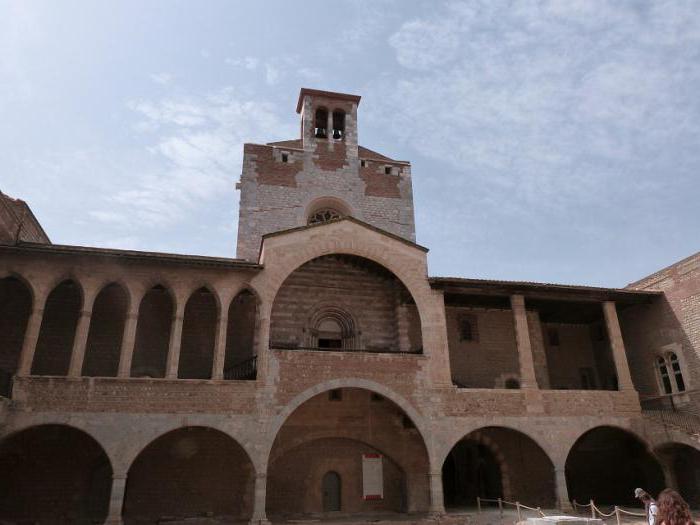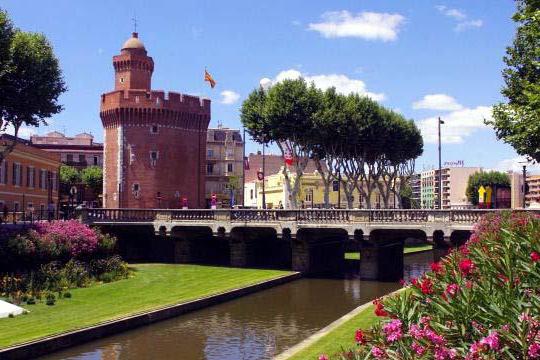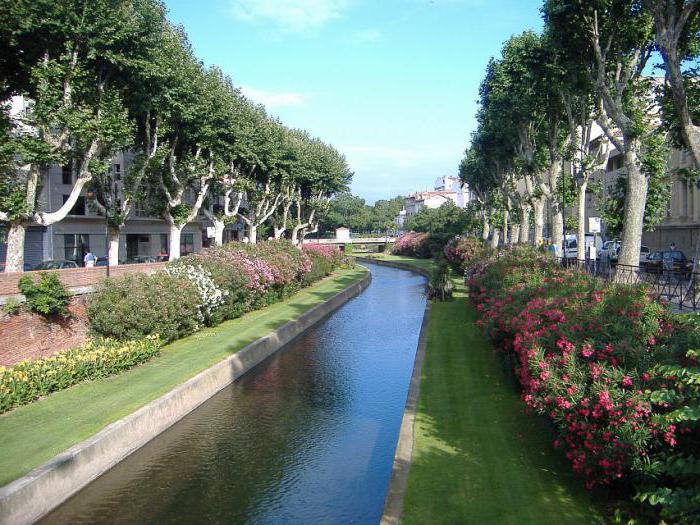Did you know that Perpignan, located on the mainland, was once the capital of the Kingdom of Mallorca? And the fact that the facade of the city's cathedral is also lined with shells? But that's not all the attractions. Perpignan (France) lies on the most fertile plain in the midst of such beautiful nature, which in itself can be an object of tourism. The Pyrenees, going down to the east to the sea, go down, but the three-headed mountain Canigou still rises in all its majestic beauty. And the valley through which the river Teth flows is all planted with vineyards - green in summer, red in autumn. Perpignan is often disrespectfully regarded only as a transit point on the way from France to Spain. Through it runs the road from Montpellier to Barcelona or Girona. But this city deserves more. Stay there for at least two or three hours to see its main attractions.
Perpignan, France: location
Just thirteen kilometers from the magnificent sandy beaches of the Mediterranean Sea lies the small city of Perpignan by modern standards (only one hundred and twenty and a half thousand inhabitants). A regular bus runs along the coast. So Perpignan can also be considered as a place for a beach holiday. Stepping into the narrow streets of its historical center, you involuntarily wonder: is this really Spain? Everything about the city is reminiscent of Catalonia. By the way, it is only thirty-one kilometers away. Now the city is the administrative center of the Eastern Pyrenees department. And if we consider the map of France in terms of historical provinces, then Perpignan is the capital of Roussillon. The most convenient way to get to the city from Spain. Fortunately, there is no real border between countries anymore. The nearest major city with an international airport is Barcelona. From the capital of Catalonia to Perpignan - two hundred kilometers. On the high-speed autobahn AR-7, the path can be covered in two hours. There are buses from Barcelona Nord to Perpignan. And from Marseille, the journey along the A-9 highway will take more than three hours. After all, you have to overcome three hundred and twenty kilometers. 
City of Perpignan (France): history
For the first time this city was mentioned in chronicles in 927. The Counts of Roussillon made it their capital. They ruled the city until 1172. Later, Perpignan, with the lands surrounding it, departed under marriage contracts to the Counts of Barcelona. When they became kings of Aragon, the division of the Catalan lands was carried out. Jaime the First gave the Balearic Islands and Perpignan to his youngest son, Jaime the Second. Then the city began to flourish. From 1276 until the middle of the fourteenth century, Perpignan had the status of the capital of the Kingdom of Mallorca. Jaime II himself and his two descendants lived here in a beautiful palace. And even when the kings of Mallorca moved to the islands, choosing Palma as their capital, the city flourished. Only during the period of centralization of power and absolute monarchy did Perpignan become a quiet province. In the seventeenth century, when France and Spain clashed over the right to own Roussillon, the city became a bone of contention. Perpignan turned into a fortress. But according to the decrees of the Iberian Peace (an agreement of 1659), the city went to Louis the Fourteenth. As part of France, Perpignan remained a provincial quiet corner in the outskirts of the kingdom. The city walls, once withstood the onslaught of the besiegers, fell into disrepair and were demolished in the nineteenth century. In 1936, Perpignan received thousands of refugees from Spain fleeing the civil war. And when France lost its territories in North Africa, exiled colonists settled here since the 1960s. 
Things to consider as a tourist in Perpignan
Due to historical and cultural features, this city is strongly influenced by Spanish traditions. Perpignan seems to die out in the daytime. Everything - shops, museums - closes for a siesta. But tourists can spend this time in parks, especially in La Miranda. Perpignan is a very green city. You can sit on the emerald grass in the shade of plane trees on the banks of the Tet and take a nap for a couple of hours yourself. Dishes in local restaurants will be offered mainly from Catalan cuisine. But not only tapas, sangria and paella can be tasted in Perpignan. The city is also full of restaurants and cafes of European and even Asian cuisine. And then, thoroughly refreshed, go sightseeing. Perpignan (France) is very compact. All interesting places are located in the historical center of the city. Except one. Those tourists who came to Perpignan by train should pay attention to the interiors of the train station. They were painted by Salvador Dali himself. 
Le Castellet
Now let's go from the station to the central part of the city (it's better to take a bus) and start exploring historical sights. Perpignan (France) was once located in the ring of fortress walls. Part of the fortification complex was Le Castellet, a small two-tiered tower. It was built in 1368. After the French conquest, the small fort was converted into a city gate. But the suspension bridge, as well as the adjacent prison, have not survived to this day. When the dilapidated ramparts were demolished in the nineteenth century, Le Castellet, the "little stronghold", escaped destruction. It was decided to leave it and transfer it to the Museum of Catalan Art. Guidebooks recommend visiting it before a more detailed acquaintance with the city. And on the top tier of the tower there is an observation deck from where a wonderful view of the city opens.
Palace of the Kings of Mallorca
Together with Le Castellet, this residence is the hallmark of the city of Perpignan (France). Attractions - photos in guidebooks confirm this - are very numerous. The castle rises on a small hill. Having inherited the Kingdom of Mallorca from his father, Jaime II in 1276 laid the first stone in the construction of his residence. Of course, the palace was rebuilt several times. But, in principle, the Gothic look of the ensemble has been preserved. Visitors are first of all struck by the powerful defensive walls of the palace-citadel. After passing the barbican, you find yourself in an unexpectedly cute patio. The original donjon (feudal tower) has been preserved, to which the royal chambers were later added with a beautiful gallery on the second floor. Little remains of the interiors. But visitors are led through the throne room, the private apartments of the royal couple, the dungeons. An interesting two-tiered palace church. The first floor of this chapel is dedicated to Mary Magdalene, and the top floor is dedicated to the Holy Cross. 
Cathedral of Saint John the Baptist
This sacred building is simply a must to visit, even if you consider the city of Perpignan (France) to be just a transit point. The sights of the cathedral are hard to overestimate. It was founded in 1324 by King Sancho. But due to political turmoil with members of the Aragonese dynasty, the cathedral still could not be completed. Long-term construction was erected occasionally, in parts, at long intervals. This has led to a variety of styles. The Cathedral of St. John the Baptist was completed only by the eighteenth century. The facade of this temple surprises with red brick and river pebbles. But even more amazing is the interior of the cathedral. A luxurious altar, rosettes, stained-glass windows, an organ - an amazing mixture of Gothic and Baroque. In one of the chapels lie the remains of King Sancho the First. 
Church of St. James (Jaime)
This temple is located five hundred meters from the cathedral. The church is the oldest surviving sacral building. It was founded in 1245 by the father of the first ruler of Mallorca, Jaime the First of Aragon. But the small Cathedral of St. James makes the city of Perpignan (France) famous. Reviews of tourists say that on Good Friday, it is from here that the Sanch procession begins. People dressed in crimson and black hooded cassocks (like those of the Ku Klux Klan) march in complete silence through the streets of the city. This tradition originated in the fifteenth century and is designed to provide moral support to those condemned to death. In addition, the interior of the church is considered the most beautiful in the city. Particularly noteworthy is the icon of Our Lady of Hope and the baroque altar of the Rosary. 
Rigaud Museum
Salvador Dali glorified the city of Perpignan (France) not only by the railway station. Several of his works are exhibited in the Rigaud Museum, which is located at 16 rue l'Ange. There are also paintings by Catalan and Spanish masters who lived from the fourteenth to the sixteenth century, as well as French painters - primitivists and avant-garde artists. The museum is open daily, except Monday, from half past eleven to six in the evening. What is interesting: there is no break for a siesta.
Maritime Exchange
This building has long been the focus of business life located near the coast of the city of Perpignan (France). The photo of the Sea Exchange also adorns the guidebooks. The building was built in 1397. Once upon a time, merchants who arrived on ships gathered there and formalized trade deals there. It was also possible to charter a ship with a crew there. After the suppression of the Catalan uprising in the seventeenth century, the French authorities carried out public executions of the opposition to the regime in front of the Bourse building. And in the thirties of the twentieth century, guides met in a cafe on the square, helping the Spaniards to escape from the power of Franco. Not far from the Bourse rises the city hall of Perpignan. This sixteenth-century building is also built in the Majorcan style (the cladding used a flat
Attractions near the city
In addition to the wonderful beaches, I would like to highlight a few more interesting places that the South of France is famous for. Modern Perpignan is located just five kilometers west of ancient Ruscino (which gave the name to the province of Roussillon). The ancient Roman forum has been preserved, and archaeological excavations have revealed many interesting artifacts to the world. Salses Castle was built by Ferdinand of Aragon in 1497 on the site of an ancient fortress that guarded the salt route from Spain to France. This fort is located sixteen kilometers from the center of Perpignan.
Gastronomic tour
A real feast for the stomach can be arranged if you visit numerous oyster farms. Perpignan (France) is famous for breeding these mollusks. The warm sea, shallow sandy bottom and the absence of strong currents contribute to the ripening of especially large specimens. You can drive along the coast and buy oysters from direct producers on farms. But you can do it easier: visit Port Leucate in Perpignan along Espanal Avenue and choose the right product.
